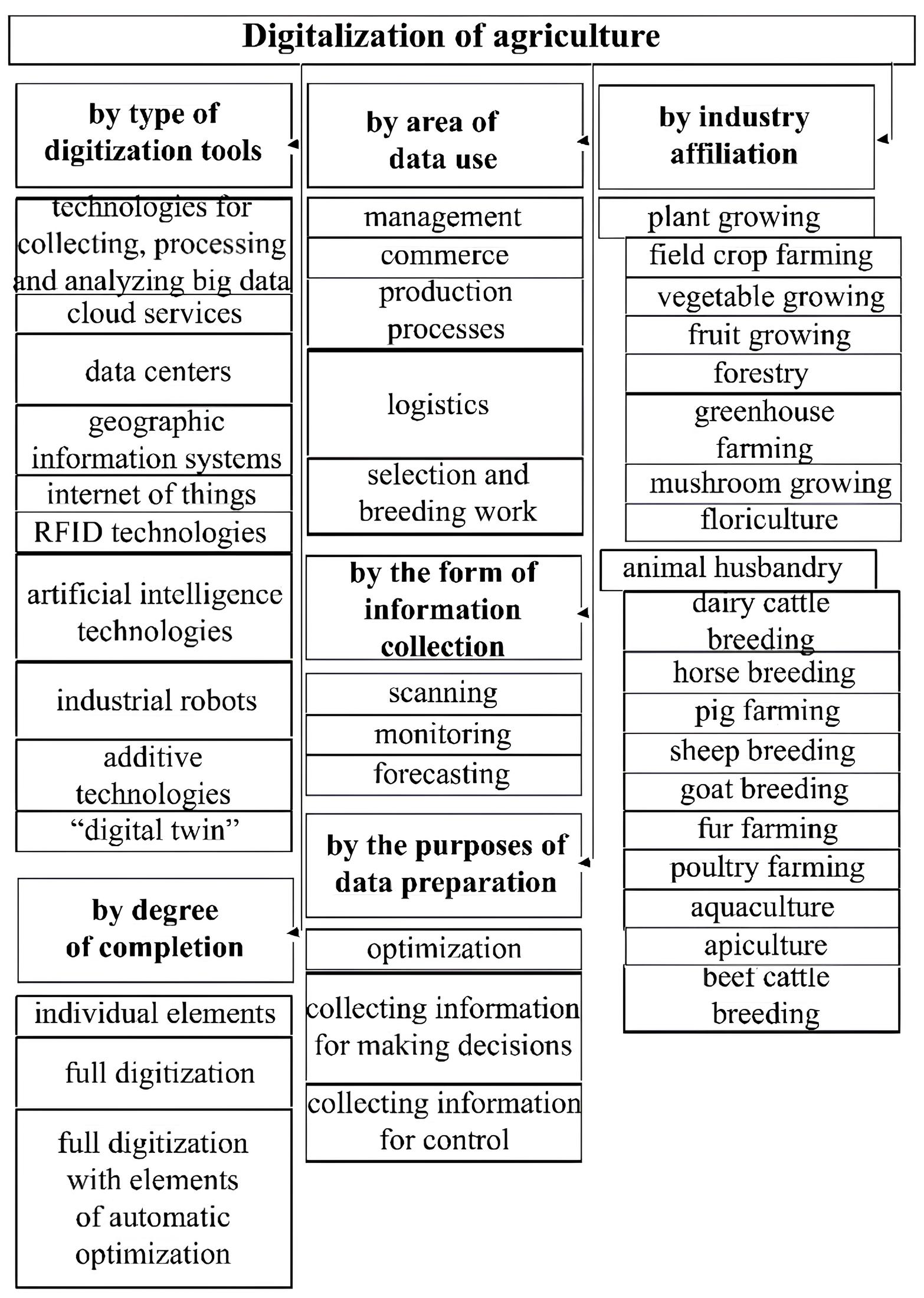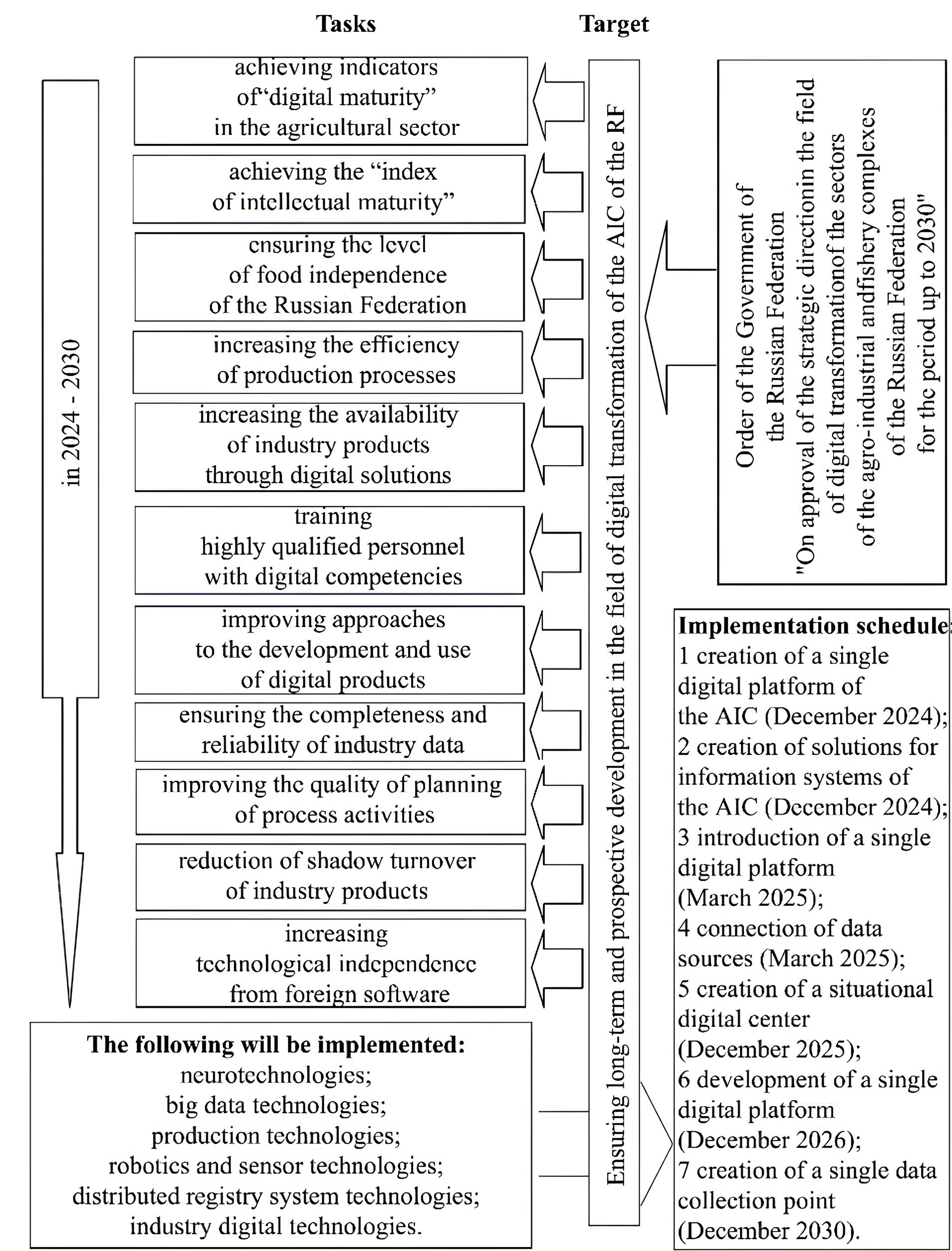Перспективы развития цифровизации в сельском хозяйстве
Перспективы развития цифровизации в сельском хозяйстве
Аннотация
Цифровизация — одно из главных условий поддержания конкурентоспособности экономики. Это приводит к взрывному росту числа предприятий, использующих разнообразное программное обеспечение. Все большая доля сельскохозяйственных предприятий переходит к комплексному решению управленческих задач. Исследования показали, что в Самарской области основным направлением цифровизации является растениеводство. Высокая рентабельность растениеводства (30–50% в зависимости от года) позволяет предприятиям инвестировать в развитие. Использование автоматизированных систем вождения, беспилотных авиационных систем, навигации и других видов цифровизации производственных процессов позволяет в среднесрочной перспективе не только сократить потери, связанные с человеческим фактором, но и оптимизировать производство, повышая его рентабельность. В настоящее время более ¾ самарских сельхозпредприятий используют цифровые технологии.
1. Introduction
Digitalization is an optimization process that involves the interaction of analog data and work processes when converting them into digital form
, . Digitalization involves several levels, starting from the digitalization of individual aspects of technology for the widespread implementation of automation, reducing the negative effect of the human factor, improving production operations and, as a result, increasing profitability and improving the economic efficiency of the economy and its individual elements , , . Decision-making within the framework of digitalization becomes easier as a result of obtaining more information and a better degree of its structuring , . Timely provided, organized information significantly reduces the time required to make a good decision, but also allows you to predict the manifestation of unfavorable situations in advance, create conditions for their elimination or elimination with minimal damage. This makes the management system more flexible, active, and relevant to the tasks being solved. Agricultural production has a number of features that require special approaches to the digitalization strategy of the industry. The distribution of production processes over a large territory, the use of biological objects, the strong influence of factors that are practically uninfluenceable by the manufacturer and a number of others do not allow the full use of approaches to the implementation of digitalization elements that have been developed in other industries (for example, in industry) .
Figure 1 - Classification of agriculture digitalization types
- increased productivity and increased production efficiency. Digitalization allows for an increase in the speed of production processes based on their automation, a reduction in the influence of the human factor and an increase in the efficiency of working with data based on the use of specialized IT products, which reduces the likelihood of errors and duplication in work;
- improved quality of services provided. The use of IT solutions ensures a higher quality of work with contractors, which increases the attractiveness and image of the enterprise among potential clients;
- reduced costs. The implementation of IT solutions allows for the optimization of the cost part of production, work with clients and enterprise management by eliminating unnecessary operations, performing them in a timely manner (for example, meeting agricultural deadlines), reducing excess personnel, etc.;
- increased competitiveness. Organizations implementing specialized software increase their competitiveness compared to competitors working on the basis of traditional technologies;
- improved interaction within the enterprise. Based on digital technologies, communication barriers between employees of the organization are reduced, which increases the speed and efficiency of their interaction, reduces the time for decision-making;
- automation of production elements. IT solutions allow many production processes to be implemented automatically, which reduces their execution time and allows you to focus on the remaining ones;
- improvement of data analytics. As part of the digitalization process, it is possible to cover a wider range of production characteristics, better structure them for, which provides the enterprise with the opportunity for more informed management decisions
, , .The most common digital technologies in the implementation of IT solutions are: Big Data technology, Enterprise Resource Planning (ERP) models, digital design and modeling (CAD), simulation modeling, mathematical modeling, computer and supercomputer engineering (CAE, HPC) and optimization (CAO), technological preparation of production (CAM), network planning technologies (CPM, PERT), "smart" models, "digital twins", product data management technologies (PDM) and product lifecycle management technologies (PLM); new materials; additive technologies (3D printers, technologies, approaches and methods of working with source materials, development and operation of consumables); industrial sensors; robotics technologies; enterprise management information systems; etc.
The purpose of the study is to determine the trends in the development of digitalization of the agricultural economy in the context of the Russian Federation. Within the framework of this topic, it is proposed to solve the following problems:
- determining the trends in the development of digitalization in the Russian Federation and the Samara region;
- identifying the main areas for improving production processes;
- determining the relationship between digitalization processes and the results of activities in agricultural production.
As a basis for studying digitalization processes, it is proposed to use the author's classification of digitalization of agriculture (Fig. 1).
2. Results
The use of information technology is an important factor in the development of agriculture in the region. According to the Research University Higher School of Economics (2024), agriculture is one of the leaders in the development and implementation of digital technologies among economic sectors. In such areas as geographic information systems, the Internet of things, industrial robots and a number of others, the share of agricultural organizations using these IT technologies exceeds the average values for the economy (Table 1).
Table 1 - Use of digital technologies (in % of the total number of organizations) in the Russian Federation
Title | Share, % |
Technology for collecting, processing and analyzing big data | 23.7 |
Cloud services | 25.5 |
Data processing centers | 9.1 |
Geoinformation systems | 15.6 |
Internet of things | 11.9 |
RFID technologies | 9.4 |
Artificial intelligence technologies | 4.7 |
Industrial robots | 4.8 |
Additive technologies | 0.8 |
"Digital twin" | 20.0 |
The process of digitalization development in the agriculture of the Russian Federation is regulated by the Order of the Government of the Russian Federation dated 23.11.2023 No. 3309-r "On approval of the strategic direction in the field of digital transformation of the sectors of the agro-industrial and fisheries complexes of the Russian Federation for the period up to 2030" (fig. 2).

Figure 2 - State support system for digitalization of the agro-industrial complex
The indicators reflecting the effectiveness of the specified goal are: creation of a single digital platform for the agro-industrial and fisheries complexes: in 2024 — 40%; in 2030 — 100%; creation of the Situation Digital Center of the Ministry of Agriculture of Russia and the Federal Agency for Fisheries: in 2030 — 100%; the number of industry indicators for which data is collected on a single digital platform for the agro-industrial and fisheries complexes: in 2024 — 50 thousand indicators; in 2030 — 100 thousand indicators. A single digital platform for the agro-industrial and fisheries complexes will allow the creation of a single industry database of the agro-industrial complex, which will facilitate the receipt of a single homogeneous array of comparable data necessary for making informed management decisions, and therefore, obtaining operational information on the current state of the agro-industrial complex.
Agriculture in the Samara Region has shown a sharp increase in agricultural production in the last decade. Compared to 2015 data, the growth in value terms was 2.23 times (Table 2). The growth in the cost of manufactured products is associated not only with inflation processes, but also with an increase in the gross harvest of plant products in the region. If at the beginning of 2010 the grain harvest was 1.0–1.5 million tons, then in 2024 it was 2.6 million tons.
Table 2 - Agricultural products produced in the Samara region
Indicator | 2015, million tons | 2019, million tons | 2020, million tons | 2021, million tons | 2022, million tons |
Agricultural production | 82.2 | 100.4 | 124.4 | 149.3 | 183.0 |
Crop production | 46.7 | 64.7 | 84.9 | 106.3 | 135.2 |
Livestock production | 35.5 | 35.8 | 39.5 | 43.0 | 47.8 |
One of the factors for increasing production volumes (along with improving technology) is the optimization of management processes associated with an increase in the share of processes and the use of elements of IT technologies. As can be seen from the data in Table 3, the share of agricultural enterprises using digital technologies is gradually leveling out with the average level for the regional economy. If in 2020 the gap was 14.6 percentage points, then in 2022 it decreased to 0.7 percentage points.
Table 3 - Use of digital technologies in organizations
Indicator | 2020, % | 2021, % | 2022, % |
Total | 74.8 | 79.2 | 76.0 |
Agriculture, forestry, hunting, fishing and fish farming | 60.2 | 70.3 | 75.3 |
Note: as a percentage of the total number of surveyed organizations
The peculiarities of agricultural production include distribution over large territories, which is why the problem of providing access to the Internet is acute. In the conditions of the Samara region, this problem is being solved actively, thanks to the high population density and the implementation of various state programs to ensure the availability of information networks (Table 4). However, the problem of creating websites for agricultural enterprises remains unresolved. The share of such organizations in agriculture is significantly lower than the average for the economy.
Table 4 - Use of global information networks in organizations in 2022
Indicator | Fixed (wired and wireless) Internet, % | Mobile Internet, % | Organizations that had a website on the Internet, % |
Total | 73.1 | 41.2 | 42.0 |
Agriculture, forestry, hunting, fishing and fish farming | 71.2 | 42.5 | 27.4 |
Note: as a percentage of the total number of surveyed organizations
Table 5 - Use of special software in organizations
Indicator | 2015, % | 2020, % | 2021, % | 2022, % |
Organizations that used special software - total | 67.5 | 61.3 | 68.5 | 65.5 |
for financial settlements in electronic form | 41.6 | 38.0 | 41.1 | 45.5 |
electronic reference and legal systems | 41.5 | 41.1 | 43.5 | 46.4 |
for managing sales of goods | 17.8 | 19.5 | 20.9 | 28.0 |
for managing purchases of goods | 27.0 | 24.8 | 27.2 | 33.0 |
for providing access to databases through global information networks | 24.7 | 21.9 | 22.7 | 28.9 |
training programs | 12.0 | 15.6 | 17.7 | 27.3 |
for managing automated production and/or individual technical means and technological processes | 13.8 | 8.7 | 9.1 | 17.5 |
for design | 9.1 | 11.4 | 12.2 | 18.0 |
editorial and publishing systems | 3.4 | 6.5 | 7.0 | 12.6 |
CRM systems | … | 13.5 | 15.5 | 23.6 |
ERP systems | … | 14.9 | 16.7 | 24.2 |
SCM systems | … | 5.9 | 6.4 | 15.5 |
for scientific research | 2.5 | 4.4 | 2.2 | 11.3 |
other | 26.4 | 19.4 | 19.7 | 26.4 |
Note: as a percentage of the total number of surveyed organizations
Among the software, the most widespread are software products related to finance and legal issues (45.5% and 46.4%, respectively). This is due to the mandatory maintenance of automated accounting and obtaining information about changes in the regulatory framework for doing business. The share of enterprises using software products related to production process management increased by 8.4 percentage points from 2020 to 2022. This is typical for both livestock organizations (mainly herd management programs) and crop production. The share of IT products for training increased from 15.6% to 27.3%.
In the Samara region, since 2023, along with non-specialized types of state support, grants have been allocated for the implementation of projects related to the introduction of modern innovative products and technologies in the agro-industrial complex.
3. Challenges and Limitations of Digital Transformation
However, the use of digital technologies faces a number of limitations. It is believed that digitalization is one of the leading elements of the emerging new economic order, the transition to which is associated with the need for huge financial resources. If previous transitions were financed by the exploitation of colonies, then in modern conditions these opportunities are limited. Therefore, the EU, the USA and other attractive markets are preparing special tariff restrictions for less developed countries in order to finance the reconstruction of their economies. This will automatically reduce the attractiveness of imported goods, including from the Russian Federation.
Another group of restrictions is associated with problems in the development of internal infrastructure. The larger territory of the country, the focus of the economy on the development of the raw materials industry and a number of other factors have led to a certain lag in the development of the infrastructure necessary for the active digitalization of the economy. After the events of 2014 and the introduction of numerous sanctions, the country's leadership realized the need to accelerate the development of digitalization in industry and agriculture. The unavailability of foreign software, the lack of domestic IT solutions in the early stages had a significant impact on the state of industry and agriculture. Therefore, the state is now developing digital areas at an accelerated pace. There are already many examples when industry and agriculture receive world-class developments. Increasing the number of courses and students in IT specialties both in specialized and industry universities, stimulating the development of digital solutions, putting into operation digital platforms "Agricultural Land", "Grain", "Seed Growing", "Mercury", "Saturn" and others will allow enterprises not only to get used to working with computer applications, but also to understand that digitalization allows reducing the labor intensity of production processes, implementing optimization elements, reducing costs, increasing production efficiency and profitability.
The third group of restrictions is associated with a certain traditionalism and patriarchy of agriculture. After the 90s, Russian agriculture faced the task of restoring production. Until now, despite the use of new technologies and machines, from the point of view of digitalization, agriculture is traditional — individual elements of digital technologies are used (herd management, navigation, accounting), but comprehensive solutions are still lacking. This is due not only to the objective limitations of the technologies used, but also subjective ones — farmers have not yet fully realized the possibility of such solutions and their benefits. For example, in the United States, to predict the behavior of bees, more than 1000 sensors are installed in each hive, monitoring individual parameters of microclimate, behavior, etc., which allows you to determine and respond to unfavorable situations in advance
. The same applies to other sectors of the agro-industrial complex.4. Conclusion
The problem of digitalization development in the agro-industrial complex is very acute due to the widespread introduction of IT solutions abroad and the need to maintain the competitiveness of the industry. High profitability of crop production and state support from federal and regional authorities make it possible to solve it in an accelerated manner. Recently, numerous projects on digitalization of agriculture have been implemented in the region, both in the field of direct production and in personnel training, e-commerce and other areas. Thus, the following problems are solved: reducing the shortage of specialists in the agro-industrial complex as a whole, including those capable of implementing digital solutions; preparation of training courses and programs on the use of modern technologies for collecting and analyzing information in the agro-industrial complex; increasing the level of use of optimization tools, developing forecasts and plans using IT solutions; insufficient availability of the Internet in certain territories of the region; implementation of a single digital platform for obtaining industry data on the basis of the Ministry of Agriculture and Food of the region or the Samara-Aris consulting service; correction of insufficient development of the electronic system for product sales; high capital intensity of digital transformation activities.
